After a full week in Tiruvannamalai I was feeling more comfortable with my surroundings. However, as I observed in my journal: “I can’t say it’s all been a pleasure.” One disconcerting element was that the toilet in my room smelled like sewage and intermittently I found it nauseating. I finally broke down and bought some citrus toilet bowl cleanser at Nigiri Market that masked but did not eliminate entirely the odor.. Progress.
Another of the challenges was being constantly vigilant about what went into my mouth, including being sure to use bottled water when brushing my teeth and taking care not to swallow water when showering.. Easy to forget, especially in the morning when I was not fully awake and alert. Quite a few people in the sangham seemed to be having varying degrees of digestive disturbance, and I was no exception. Unfortunately for me, it was hard to figure out cause and effect. My digestion had been touchy ever since my father passed away three years before. It had been accompanied by an almost constant burning sensation in my mouth that doctors hadn’t been able to accurately diagnose or cure.. The long and the short of it was that I could never sure when my digestive system was out of whack whether it was related to something I had eaten, attributable to the deep psycho-spiritual work that I was doing or it was the same-old same-old flaring up. Since I seemed to be faring no worse than anybody else, I didn’t spend too much time trying to figure it out except when it seemed like some treatment might be required.
Although I wasn’t feeling tip-top, I decided to go on an outing with three other women to visit the caves where Ramana had lived and meditated for the better part of his life. We sojourned by tuk tuk on the now familiar route to the Ramana Ashram. We walked through the grounds to the and set off on a meandering uphill trail about 3-feet wide set with large flat stones that led up the mountain. From time to time we passed vendors in makeshift stands imploring us to purchase water or bananas or hand-carved stone Indian gods and goddesses. It was comfortably warm when we started out, but the temperature rose steadily as we trekked along.
In about a half an hour, we arrived at the Skandashram cave, where Ramana lived during the latter part of his life, from 1916 to 1922. At the entrance to the cave was a small enclosed porch where several people were meditating. The cave itself was small; an altar held a photograph of Ramana illuminated by the flickering flame of a votive candle. Four or five people were seated on the floor meditating. When someone got up and left the entryway porch, and I hastened to take the spot. From where I was sitting I could see the photo of Ramana inside the cave. A sweet, loving energy permeated the small area. Periodically people stepped in, went to the door of the cave, leaned over to dip their fingers into the small bowls of sacred ash on the doorsill and touched their fingertips to their foreheads leaving traces of the ash – an gesture of surrender to the Divine. They then placed their hands in prayer position over their heart center, bowed and exited.
Once seated in the entryway, my mind quickly slowed to a stop, and I fell into a deep sense of peace and tranquility. I sat for about 10 minutes until one of the meditators in the interior cave got up and left. I crossed the threshold and took a place just a few feet from the altar. I felt like I was on holy ground. The sweetness and love only intensified in this chamber, and I became lost in the silence. After about 10 more minutes, my tranquility was interrupted by the thought that my friends, who had not joined me in the cave, might leave me behind. I came back to waking consciousness and emerged from the cave, blinking in the bright sunlight, and found them assembled and preparing to depart. Relieved to find them still there, I joined them, and we headed down a stone path toward the Virupaksha cave where Ramana had meditated for 17 years..
I took my shoes off and went in. It was pitch black except for a small candlelit altar to Ramana, which cast minimal light into the recesses of this much larger enclosure. I stood motionless, waiting for my eyes to adjust to the light so I could determine if there was any place to sit. Suddenly, from out of the darkness, a hand reached out and grabbed hold of my arm. Initially startled, I relaxed when I realized that it was Beverly, someone from our group who had been going up to the Virupaksha cave every day and sitting for four to five hours. She led me back to a wall where there was an open space beside her. Generously, she offered me her meditation pillow, and I sat down. I felt like weeping from gratitude -- it was as if I had been touched by the hand of benevolence.
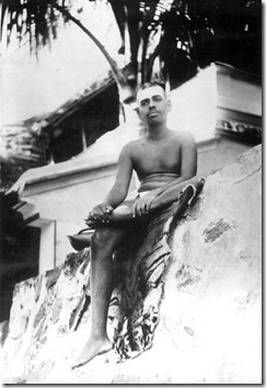 Ramana as a young man outside Virupaksha cave
Ramana as a young man outside Virupaksha cave This time my friends were nowhere to be seen. With no small amount of trepidation at being on my own, I put on my shoes and started back down the path. I was soon joined by our self-appointed guide who greeted me, saying something I didn’t understand. I bowed to him with my hands in prayer position over my heart center and walked on. He followed me, and I quickly realized that he wanted money, so I gave him some rupees. He indicated, however, that I should not return the way I had come, motioning instead down a path that led in the opposite direction. I wasn’t at all sure that route would take me back to the Ramana Ashram. He was insistent, so despite misgivings I followed his directions and took the path downhill for about a half a mile, passing no other people. Finally, I came to an area that was surrounded on both sides by mounds of garbage and human feces.. I was becoming more uncertain of the soundness of my decision. I could see the temple of Tiruvannamalai at a distanced through the smog, but it was not near the Ramana Ashram. Finally, the stench and my better sense prevailed, and I turned around and headed back the way I had come. I didn’t care how much longer the route back was, at least it was somewhat familiar.
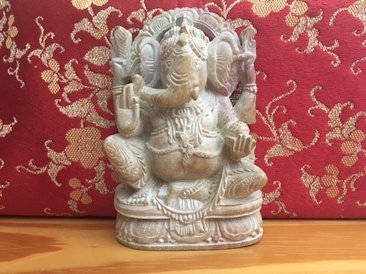 The stone Ganesha that I purchased on my way back from the caves
The stone Ganesha that I purchased on my way back from the caves By now I was gaining confidence, but I still stopped at a stand along the way and bought a lovely small stone carved Ganesha, the Hindu elephant god who is the remover of obstacles. Eventually the ashram came into sight, and I relaxed. Once I was back to the section of town I was familiar with I set out to find the Dreaming Tree, a restaurant that I had heard about from others in the sangham. I was tired, quite hungry and very thirsty. I crossed the main paved road and walked along a few dirt side streets, some with what smelled like raw sewage running in small ruts alongside. I had to ask for directions several times but I finally found saw a sign for the restaurant in the distance.. Sustenance was at hand.
Next: A Western meal, going up to the chair, and picking up my clothes from the tailor
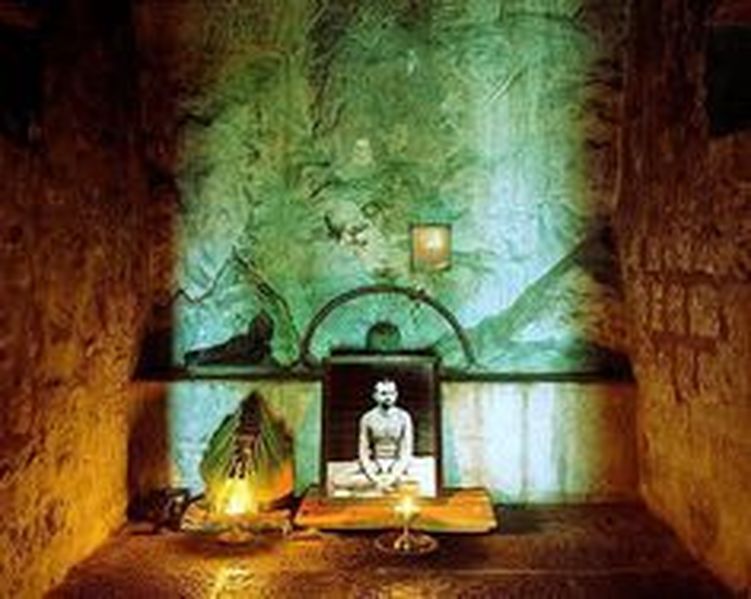
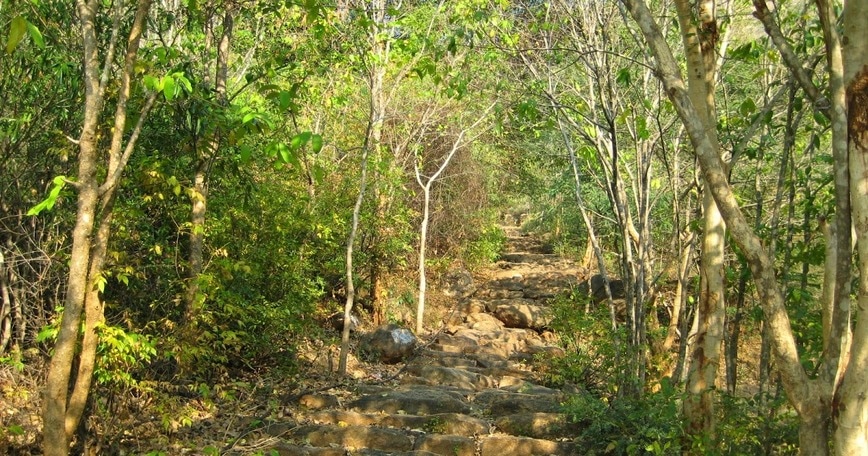
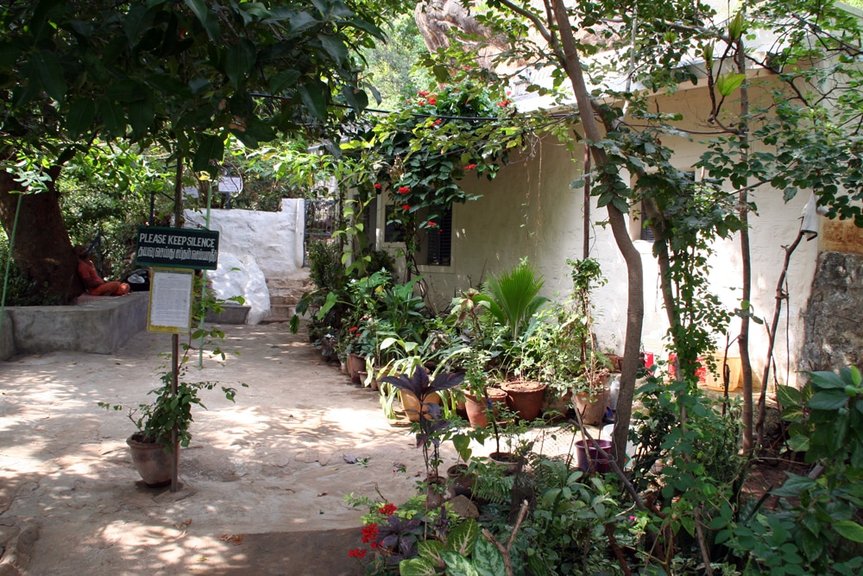
 RSS Feed
RSS Feed